How I Fell in Love with Cooking Pasta in a Skillet
A Sticky Start: Discovering Cooking Pasta in a Skillet in Tuscany
I never imagined cooking pasta in a skillet would become my go-to, but it all started in the Tuscan hills. I was 29, sweaty from hiking olive groves, when I watched a neighbor—an elderly signora—toss spaghetti into a shallow sauté pan instead of boiling it. “Più sapore,” she whispered—more flavor. She wasn’t wrong.
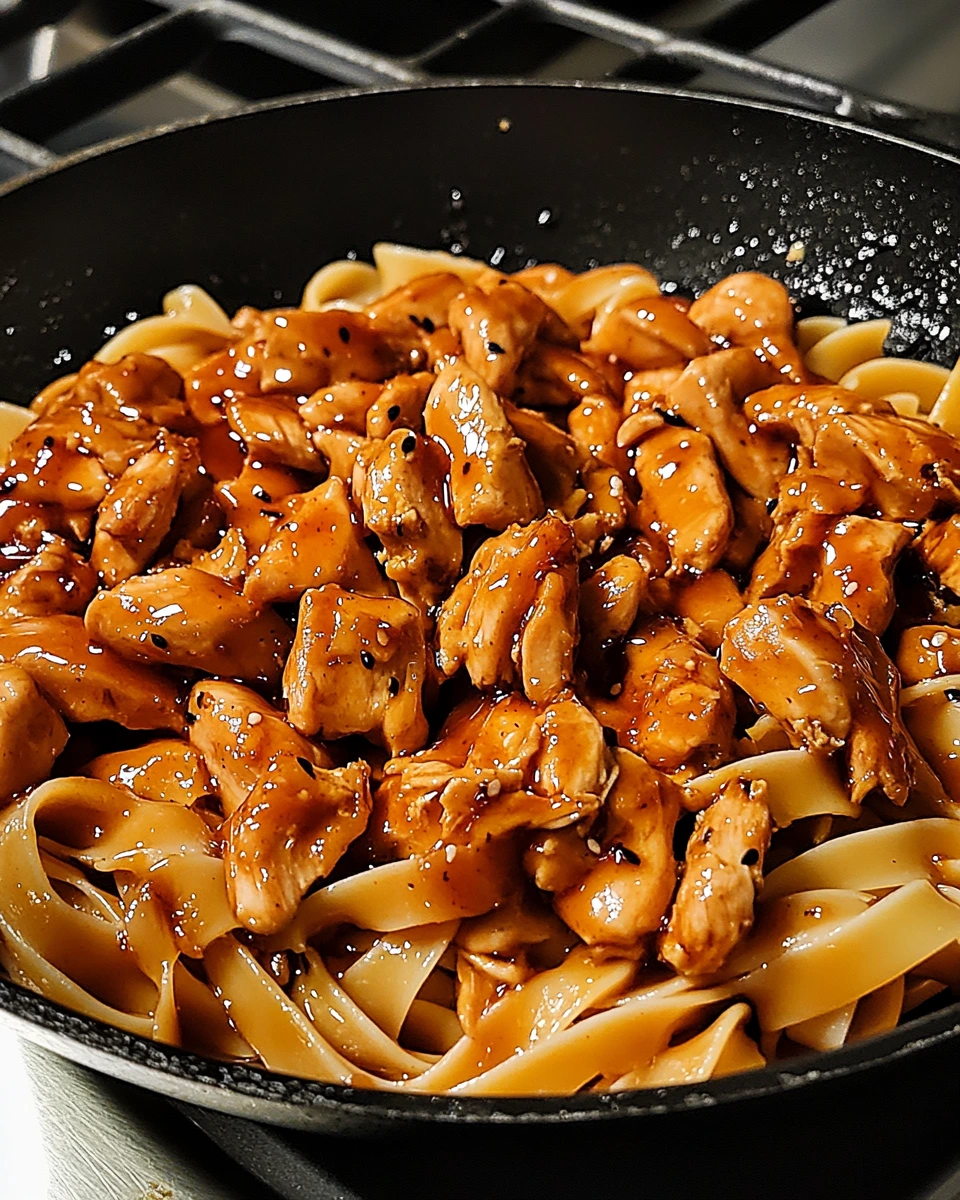
The first time I tried it, I burned the garlic. The second time, the pasta stuck. But the third time? Magic. The sauce clung to every strand, the pasta was toothy, and it felt like I’d unlocked a secret.
Cooking pasta in a skillet has since become my shortcut to soul-satisfying meals. It’s warm, quick, and perfect when Leo—the world’s nosiest beagle—is demanding attention. From sticky sauces to creamy ones, the skillet method turns pasta night into something bold and effortless.
Why Cooking Pasta in a Skillet Changes Everything
Forget the big pot of boiling water. Cooking pasta in a skillet means your noodles simmer directly in a flavorful base—like broth, sauce, or honey-soy glaze. The pasta absorbs those flavors, making each bite richer. No draining. No wasting pasta water. Just one skillet and a smarter way to cook.
Not only does this method reduce dishes, but it also saves time. You build sauce and cook noodles in the same pan, locking in flavor. It’s especially handy with recipes where balance matters.
Plus, it works with nearly any pasta type. Spaghetti, linguine, or even rotini take on extra character when you cook them in a skillet. And let’s not forget that golden, slightly caramelized skillet bottom—it’s where all the best flavor hides.
Print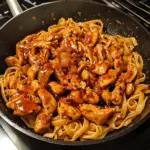
Sticky Honey Garlic Chicken Pasta Skillet
- Total Time: 35 minutes
- Yield: 4–6 1x
Description
Sticky honey garlic chicken pasta made entirely in one skillet. A sweet, savory, and spicy dish that’s bold in flavor and simple to make.
Ingredients
1 lb boneless, skinless chicken thighs, cut into bite-sized pieces
12 oz spaghetti or linguine
1/4 cup honey
1/4 cup soy sauce
4 cloves garlic, minced
1 tbsp sesame oil
1 tbsp cornstarch
2 tbsp water
1/2 tsp red pepper flakes (optional)
2 green onions, sliced (for garnish)
Sesame seeds (optional, for garnish)
Salt and pepper to taste
Instructions
1. In a large skillet, heat sesame oil over medium heat. Add the chicken pieces, season with salt and pepper, and cook until browned and cooked through, about 6–8 minutes. Remove chicken and set aside.
2. In the same skillet, add minced garlic and red pepper flakes, sauté for 30 seconds until fragrant.
3. In a bowl, whisk together honey, soy sauce, cornstarch, and water. Pour the mixture into the skillet and bring to a simmer.
4. Meanwhile, cook pasta according to package instructions. Drain and set aside.
5. Return the chicken to the skillet and combine with the sauce, tossing to coat. Add the cooked pasta and toss again to combine.
6. Serve warm, garnished with sliced green onions and sesame seeds if desired.
Notes
You can substitute chicken thighs with chicken breast, but be careful not to overcook. For a vegetarian version, swap chicken for tofu or mushrooms.
Store leftovers in an airtight container and reheat with a splash of water in a skillet.
- Prep Time: 15 minutes
- Cook Time: 20 minutes
- Category: Dinner
- Method: Skillet
- Cuisine: Asian-Inspired
Nutrition
- Serving Size: 1.5 cups
- Calories: 490
- Sugar: 14g
- Sodium: 920mg
- Fat: 16g
- Saturated Fat: 4g
- Unsaturated Fat: 10g
- Trans Fat: 0g
- Carbohydrates: 55g
- Fiber: 2g
- Protein: 30g
- Cholesterol: 85mg
Cooking Pasta in a Skillet – How It Works and What to Use
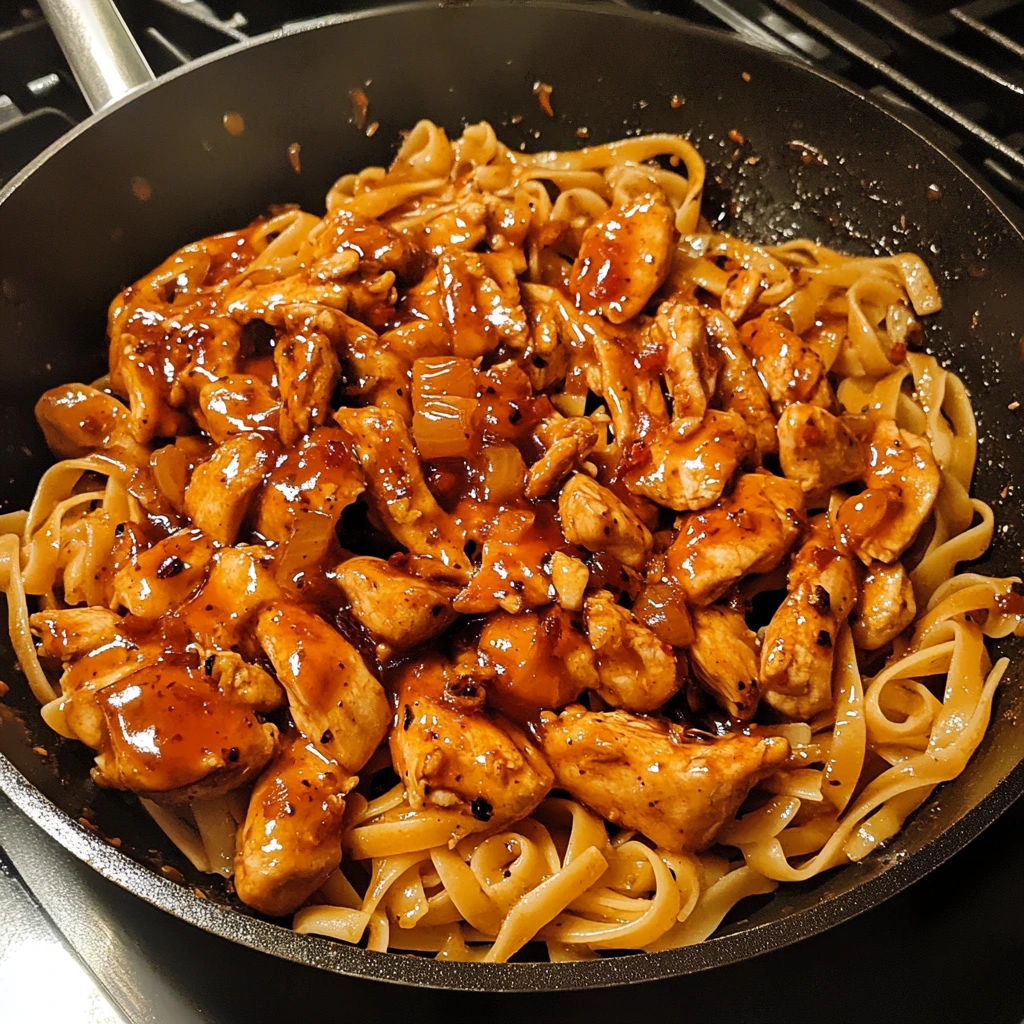
The Truth About Cooking Pasta in a Skillet
Cooking pasta in a skillet might sound like a shortcut, but it’s actually a smart, flavor-forward technique. Instead of boiling pasta separately, you cook it right in the pan with your sauce or broth. As the pasta simmers, it soaks up the flavors around it—like garlic, soy sauce, or chicken juices—making every bite taste intentional. You’re not just coating noodles here; you’re infusing them.
The water-to-pasta ratio matters. You don’t need gallons of liquid—just enough to let the pasta cook without sticking. And because the starch stays in the pan, it naturally thickens the sauce without needing cream or butter. It’s the reason why sticky pasta recipes cling so well to every bite.
This approach isn’t new. Many Italian home cooks have used it for generations, often starting the pasta in broth or directly in tomato sauce. The result is always the same: pasta that tastes more like the dish it’s meant to be part of—not just something tossed in sauce at the end.
Cooking pasta in a skillet also reduces cook time. You’re not waiting for water to boil. And with fewer pans involved, it means faster cleanup. That alone can turn a weeknight dinner from dreaded chore into a satisfying ritual.
Best Pasta Types for Cooking in a Skillet
Not all pasta shapes behave the same when cooked this way. Long strands like spaghetti or linguine work beautifully because they curl and soak evenly. They’re ideal for sticky sauces, whether soy-based or tomato-forward.
Short pastas like penne or rigatoni can be used too—but keep in mind they may need more frequent stirring and a bit more liquid to cook through. If you’re going this route, choose high-quality bronze-cut pasta. It has a rougher surface that grabs sauce better and resists overcooking.
Fresh pasta? Not the best pick for this method. It cooks too fast and doesn’t need the long simmer that skillet cooking requires.
Another tip: check your skillet size. A 12-inch pan gives noodles space to spread and cook evenly. Crowded pasta can steam instead of simmer, leaving some pieces undercooked or sticky in the wrong way.
Once you’ve found your go-to pasta shape for skillet recipes, the rest becomes second nature. Cooking pasta in a skillet isn’t just convenient—it’s a better way to let ingredients speak for themselves.
Cooking Pasta in a Skillet – Sticky Sauce & Flavor Tips
Secrets to Sticky Sauces When Cooking Pasta in a Skillet
The biggest payoff of cooking pasta in a skillet? That irresistibly sticky sauce. Unlike boiling pasta in water (where starch gets drained away), the skillet method keeps those natural starches in the pan. When combined with just the right ingredients, they turn any sauce into a glossy, clingy coating.
For this recipe, a mix of honey and soy sauce creates that iconic sticky finish. But the real star is cornstarch. Mix it with water before adding it to the skillet—never toss it in dry, or you’ll end up with lumps. As it heats, the sauce thickens, wrapping around the noodles like a glaze.
Keep the heat at a simmer, not a boil. High heat breaks sauces, especially when sugars like honey are involved. Simmer gently, stir often, and you’ll notice the sauce tighten into a silky coating that sticks beautifully to the pasta and chicken.
Stirring matters, too. Don’t just dump and walk away. Stir the pasta frequently as it cooks and absorbs the sauce. This helps release surface starch evenly while preventing burning or clumping. A nonstick skillet or well-seasoned stainless steel pan helps here.
Remember, sticky doesn’t mean dry. The sauce should hug the noodles, not glue them together. If it starts to feel too thick, just splash in a tablespoon of water or broth to loosen things up while keeping that glossy finish intact.
Flavor Boosters That Elevate Skillet Pasta Dishes
When cooking pasta in a skillet, every ingredient counts. You’re not hiding behind a big pot of water. You’re layering flavor directly in the pan, so you need bold ingredients that shine.
Start with garlic—but time it right. Add it after cooking the chicken, not before. That way, it infuses the oil without burning. Burnt garlic turns bitter fast. Next comes red pepper flakes for gentle heat (or skip them if you want a milder version).
Sesame oil? That’s your flavor bomb. It adds depth and warmth with just a teaspoon. Too much and it’ll overpower the dish, but just enough brings an earthy richness that plays perfectly with honey and soy sauce.
Don’t forget salt and pepper. Even when using soy sauce, a little salt on the chicken boosts its flavor as it browns. Pepper adds bite, especially if you finish the dish with a crack of fresh black pepper right before serving.
Cooking pasta in a skillet rewards attention to detail. Small choices—when to add garlic, how to stir, what oil you use—can turn a simple recipe into something unforgettable. These layers build a pasta dish that’s sticky, balanced, and far more flavorful than anything made in separate pots.
Cooking Pasta in a Skillet – Serving & Storage Made Simple
What to Serve with Pasta Cooked in a Skillet
Once you’ve nailed cooking pasta in a skillet, plating it becomes just as satisfying. Since the dish is bold and sticky with honey garlic sauce, a few light, fresh sides can balance the richness without stealing the spotlight.
A crisp cucumber salad or a side of sautéed greens with lemon gives the meal a refreshing lift. If you prefer a little crunch, toasted sesame flatbread or crusty baguette slices work well without overpowering the flavors.
This pasta also makes an eye-catching dinner-party centerpiece. Garnish with sliced green onions and sesame seeds right before serving. They add texture, color, and just a touch of freshness. You can even sprinkle crushed peanuts for a slight crunch if you want to lean into an Asian-inspired twist.
For drinks, a cold citrus spritz or dry white wine plays well with the sweetness of the sauce and the saltiness of soy. Nothing too sweet—you want contrast, not sugar overload.
The beauty of cooking pasta in a skillet is that it brings everything together in one cohesive, hearty meal. You don’t need much on the side—just something that complements the star of the plate.
How to Store and Reheat Skillet-Cooked Pasta
Leftovers? Lucky you. Pasta made this way holds up surprisingly well—if you know how to store it right.
First, let it cool completely before sealing it in an airtight container. Don’t pack it away while steaming hot or you’ll trap moisture, which leads to soggy pasta. A wide, shallow container works better than a deep one—it helps avoid clumping.
Store in the fridge for up to 3 days. If you’re cooking pasta in a skillet ahead of time for a meal prep plan, this dish is a solid choice. The sauce actually develops even more flavor overnight.
Reheating is simple but strategic. Add a small splash of water or broth to the pan and warm it slowly over medium-low heat. Stir gently until the sauce loosens and the chicken heats through. Avoid the microwave if you can—it can dry out the noodles and create hot spots.
If you must microwave, cover the container and heat in short bursts, stirring in between. And always test a bite before serving to make sure it’s evenly warm.
Cooking pasta in a skillet isn’t just a one-night trick—it’s a technique that rewards you again and again, even from the fridge.
FAQs About Cooking Pasta in a Skillet
Can you cook dry pasta directly in a skillet without boiling it first?
Yes, you absolutely can cook dry pasta in a skillet without boiling it first. The key is using enough liquid—such as broth, water, or a sauce base—so the pasta can absorb it while cooking. This method builds more flavor because the starch from the pasta stays in the skillet, naturally thickening the sauce.
How do you stop pasta from sticking when cooking it in a skillet?
The best way to prevent sticking is to stir often during the first few minutes and make sure there’s enough liquid in the pan. Avoid high heat, which can cause the starch to glue the pasta together. If it does begin to clump, just add a splash of water and gently stir to loosen it.
What kind of pasta works best when cooking pasta in a skillet?
Spaghetti, linguine, and other long, thin noodles perform beautifully in skillet recipes. They cook evenly and soak up sauce well. Short pastas like penne or rotini also work, but they may require a little more liquid and stirring. Avoid fresh pasta—it cooks too quickly for this method.
Can I make skillet pasta ahead of time and store it?
Yes, skillet pasta stores well for up to three days in the fridge. Let it cool completely before sealing in an airtight container. When reheating, add a splash of water or broth and warm gently in a skillet over low heat to restore its sticky, saucy texture without drying it out.
Conclusion
Cooking pasta in a skillet isn’t just a clever way to save dishes—it’s a flavor-first method that turns a simple pasta night into something sticky, satisfying, and bold. With just one pan, a handful of pantry staples, and a little know-how, you’ll get saucy pasta that clings to the fork and tastes like it’s been simmering for hours.
Whether you’re a busy home cook or just craving comfort without the cleanup, this Sticky Honey Garlic Chicken Pasta Skillet shows exactly why cooking pasta in a skillet deserves a permanent place in your rotation.
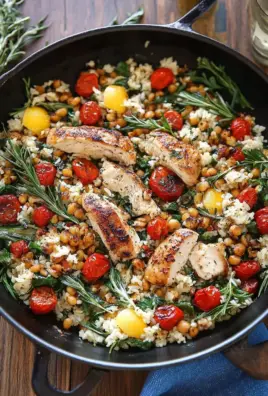
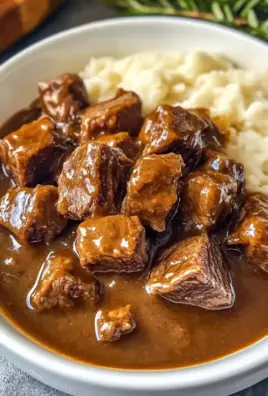
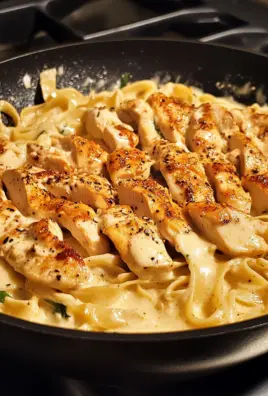
Leave a Comment